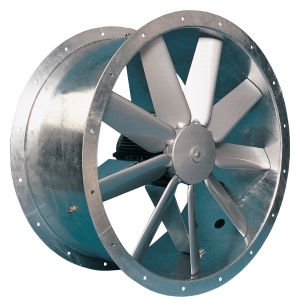Propelling an industry forward

Ventilation systems are interwoven into commercial building design, but how has the sector adapted in recent years, and what lies in store for the remainder of the decade? Andy Cardy of Fläkt Woods, scrutinises the key factors at play.
To the uninitiated, the commercial ventilation industry hasn’t appeared to change much over the last 10 years. Air still flows through air-handling units and duct-mounted fans, chillers still chill, and valves still open and close without a mention. But don’t be fooled; behind the modest façade of the latest ventilation systems hides some incredibly advanced engineering that has made significant advances over the last decade.
And, at the centre of all commercial ventilation systems in operation, lies the humble fan. This deceptively simple technology is integral to the effective running of a vast array of products, which is why recent developments in fan technology are arguably the most notable to date.
Legislation
Many of the changes over the last 10 years have been determined by improvements in fan efficiencies and a lowering of running costs. The Energy-Related Products (ErP) legislation has been the main protagonist in this area, driving modifications to impellers, motors and controls.
One of the first major improvements was back in June 2011 (EU Regulation 640/2009), when all motors with an output rating of between 0.75 kW and 375 kW had to meet the IE2 standard of energy efficiency. The next phase is scheduled for 2015 and will further improve these standards, with IE3 motors eventually becoming the minimum requirement.
In between these two steps, the industry ushered in ErP Regulation EU 327/2011, which came into force in January 2013. This applied to all fans driven, or designed to be driven, by electric motors with an input power of between 125 W and 500 kW. It specified minimum fan/motor efficiencies for all fan types, regardless of whether they operate as an individual unit or as a component within a device.
Finally, the ErP Directive for fans also has a second tier of tightened regulations due in 2015. Not only will they be far more onerous, but will also certainly rule out the sale of many products currently on the market today.
A holistic view
To comply with the latest (and forthcoming) legislation, the ventilation sector needs to adopt an integrated approach, from product conception to system design.
New materials have been the first major change, with an increased use of plastics or composites in fan impeller construction. This has been combined with new impeller designs — such as blade wing tip/trailing edge features and thinner blade sections — which are all designed to reduce energy use, noise levels and material costs.

Over the coming years, there will also be an increased use of engineering tools, such as computational fluid dynamics (CFD) and finite element analysis (FEA). While rapid prototyping, with focus on static and rotating element geometry design, will all serve to drive efficiencies to increasingly higher levels, lower running costs and reduce the time for new products to reach the market.
To complement higher-efficiency products, there will also be a greater need for fully integrated intelligent controls with BMS compatibility. For AHUs and ERUs (energy-recovery units), these are already embedded within the product design but, for fans, controls will need to be more refined to provide a more intuitive human-machine interface, as demonstrated by the Ipsum control unit from Fläkt Woods.
Future fans
So, what lies in store for fans and the ventilation industry as a whole?
In the short term, progress will be driven by further step changes in motor and fan legislation. And, by virtue of higher efficiency targets being set by future ErP Directives, overall running costs of fans and ventilation systems will continue to fall. In addition, there will be greater importance placed on effective integration of control systems into the BMSs of commercial buildings. This will be in line with the general expectation — shared throughout the HVAC industry — that control interfaces will become more user-friendly and accessible, allowing facilities managers to more proactively adapt ventilation to meet occupancy requirements.
To look beyond the next five years is a difficult task, especially for an industry that, until recently, has been relatively conservative and slow to change. It is unlikely that there will be a radical conversion to new energy sources or extreme technologies, so there will no doubt be greater emphasis placed upon manufacturers to innovate and deliver low-cost, high-performance products to suit the requirements of new commercial buildings.
Regardless of the direction and advances in the commercial ventilation industry over the next decade, fans will continue to play a central role. After all, without them, the industry would simply cease to exist.
Andy Cardy is product manager at Fläkt Woods.







